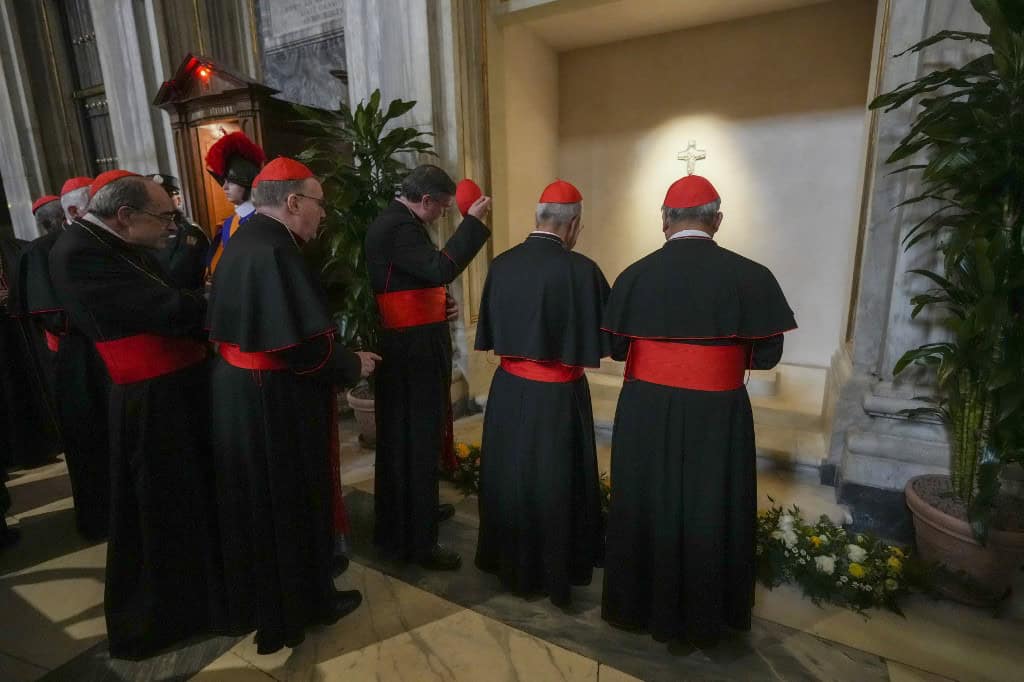Thousands of people visited Pope Francis’ tomb this Sunday, after he was laid to rest in Rome the day before following a massive funeral, as one question lingers over the Eternal City: Who will succeed the first Latin American pope? The date for the conclave to elect the next pope could be announced on Monday after another meeting of the cardinals. Church authorities chose to wait until after the Jesuit Argentine’s funeral before calling it.
While awaiting this crucial moment for the Church, over 25,000 people have so far gathered at Francis’ tomb in Rome’s Basilica of Santa Maria Maggiore, police sources indicated Sunday afternoon. Tatiana Alva, a 49-year-old Peruvian living in Canada, couldn’t hold back her tears upon seeing the tomb: “He was such an important figure for the message he tried to convey, for his dedication to the poor, the abandoned, the forgotten.”
Around 400,000 people participated in his final journey through the streets of Rome and the funeral mass at the Vatican, attended by dozens of world leaders including Donald Trump, Javier Milei, and King Felipe VI of Spain. Among the crowd were many young people who had traveled to Italy for the canonization of Carlo Acutis, the first millennial saint, an event that was ultimately postponed.
However, some visited the final resting place of Jorge Mario Bergoglio, who died Monday at the age of 88. “I would have loved to see him in real life, but this was also special. I’m happy to be close to him, a pope who helped everyone,” said Julia Graf, a 13-year-old Austrian girl.
A Heavenly Embrace
The burial site of the 266th pontiff reflects the image of simplicity he sought to project during his life. It is located along the side of the 5th-century church, in a former candle cabinet, between two confessionals. “Franciscus,” his papal name in Latin, is the only inscription on the marble tombstone, which comes from the Italian region of his grandparents. A replica of the “Good Shepherd” cross he often wore on his chest crowns the tomb.
A single white rose placed on his tomb commemorates his devotion to Saint Thérèse of Lisieux (Saint Thérèse of the Child Jesus). Francis chose this location for its proximity to the image of the Virgin Mary, “Salus Populi Romani,” to whom he prayed before and after every trip. He is the first pope to be buried outside the Vatican since Leo XIII in 1903.
About 200,000 people once again gathered this Sunday in St. Peter’s Square for a mass in his honor, many of them pilgrims participating in the Youth Jubilee. “From heaven, Pope Francis sends us his embrace,” said Cardinal Pietro Parolin, former Vatican Secretary of State, whose name is among those mentioned as potential successors.
His reformist papacy was marked by efforts to combat clerical sexual abuse, promote the role of women and laypeople, and focus on the poor and migrants, among other causes. Many faithful are concerned about the profile of the next pope.
“I hope we get another pope as competent as Francis, someone who can speak to people’s hearts and be close to everyone, no matter who they are,” said Maria Simoni, a 53-year-old Roman.
We Need to Unite
The reforms initiated by the Argentine Jesuit sparked strong criticism among the Church’s more conservative sectors, who are calling for a shift back toward stricter doctrinal focus. “What I hope from his successor is that he continues his work. Today, we need to unite, not divide,” said Malian Cardinal Jean Zerbo after a prayer gathering of cardinals at Francis’ tomb.
The conclave could begin on May 5 or 6, Cardinal Jean-Claude Hollerich of Luxembourg indicated a few days ago. According to German Cardinal Reinhard Marx, it could last just “a few days.” The precise start date could be announced Monday around 9:00 a.m. (7:00 a.m. GMT), when the cardinals are scheduled to hold their fifth meeting since the pope’s death.
The word “conclave” comes from the Latin cum clavis, meaning “with a key,” and has fascinated people for centuries. The 135 cardinal electors — those under 80 years old — vote four times a day (except on the first day) until one candidate obtains a two-thirds majority.
The result is announced to the world by burning the ballots with a chemical that releases the famous white smoke, accompanied by the cry, “Habemus papam” (“We have a pope”). The late pontiff appointed most of the cardinals eligible to vote, but this does not necessarily guarantee the election of a successor who will continue his legacy.







